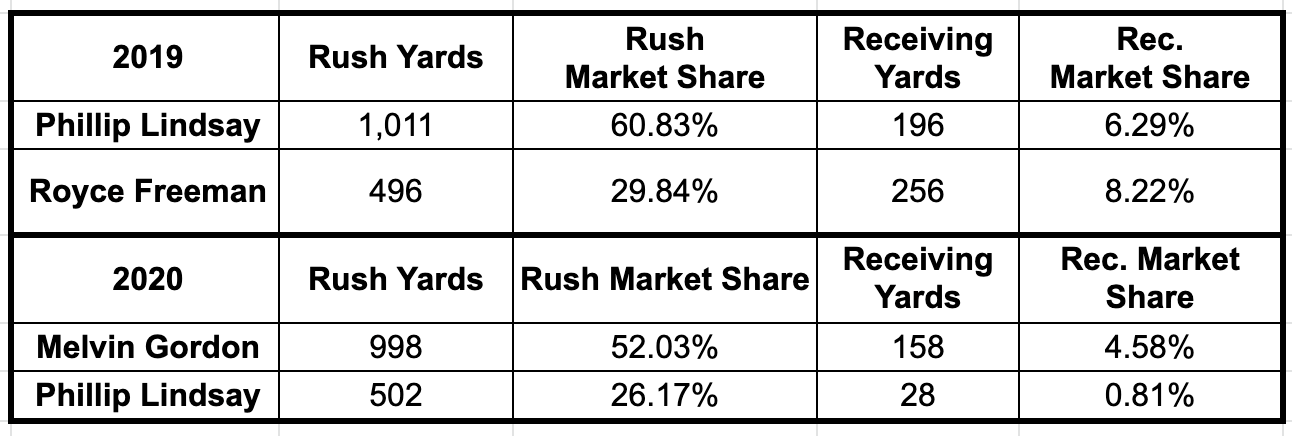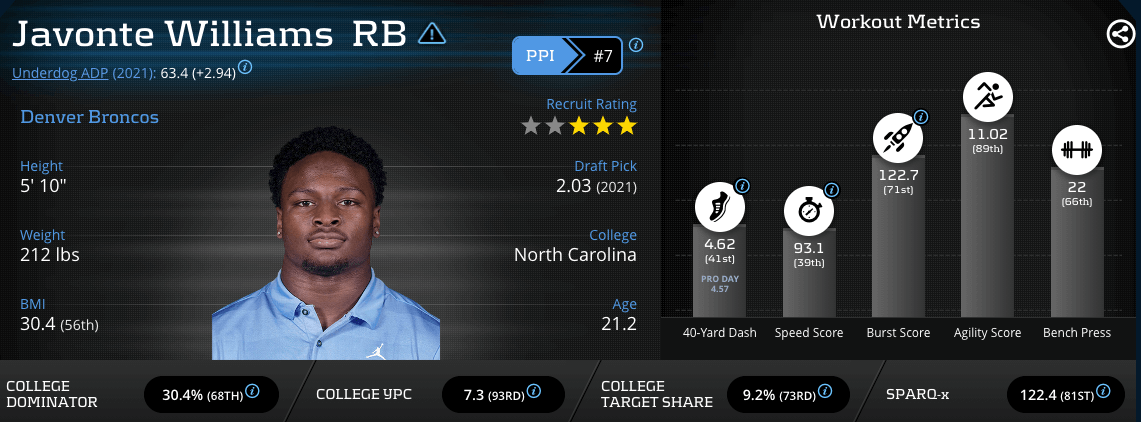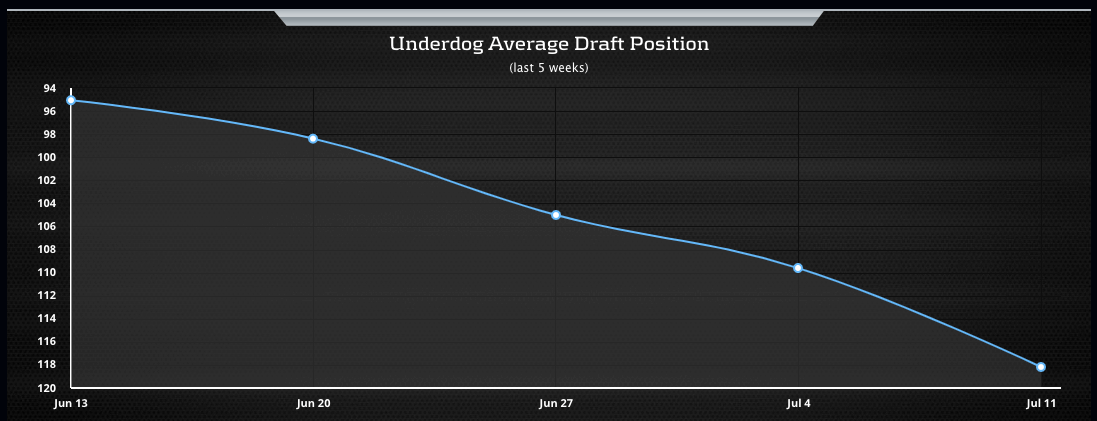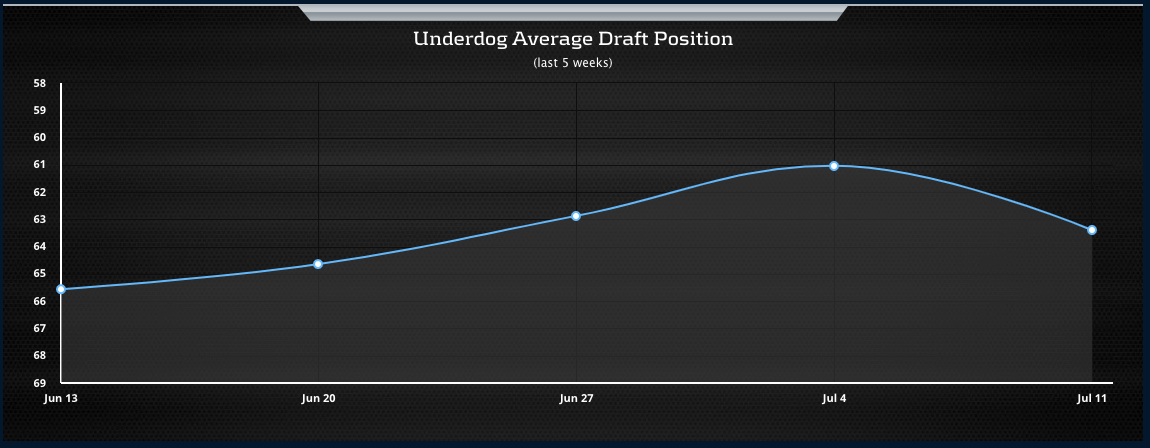Fantasy Preview: Broncos RB Committee
Just like in fantasy baseball with closers, don’t we love running back committees in fantasy football? Especially in redraft leagues, the conversations around runnings backs have opposing views. After the first 24 running backs or so, the player names make us raise our eyebrows. We’ll focus on running backs with an ADP nearby or the top duo of running backs. For this article, we’ll highlight the Broncos backfield committee, then touch on other backfields in future articles.
With the Broncos, they have a veteran in Melvin Gordon. They added Javonte Williams in the second round of the 2021 NFL Draft. A reminder that the Broncos traded up five picks in the second round to select Williams, which means they actively targeted him. We’ll look at past trends, team data, and what we project with this backfield moving forward into 2021.
Become a FantasyData Subscriber Today!
FantasyData is one of the fastest-growing Fantasy Sports sites on the web, offering all sorts of Fantasy Rankings, Player Projections, DFS tools, and Statistics. Right now, FantasyData offers an amazing deal on our Annual subscriptions. Get one full year at 50% off the regular price! That’s a huge saving.
Broncos Backfield
First, let’s discuss the team-level trends for the Broncos, then dive a little deeper into the player analysis. In 2019, 55.2% of their total offensive attempts came from the passing end. Meanwhile, 44.8% of their offensive attempts came on the rushing end. For context, the Broncos had Joe Flacco, Drew Lock, and Brandon Allen all contribute passing yards in 2019. That isn’t a great mix of quarterbacks. In the backfield, Phillip Lindsay compiled a second straight 1,000 yard season in 2018 and 2019.
Last season, the Broncos increased their offensive opportunities with 998 total compared to 913 back in 2019. However, the percentage of passing and rushing opportunities look almost identical, with 55.7% passing and 44.3% rushing. Not surprisingly, the Broncos often played from behind with a -5.20 Game Script (No. 28) yet ranked in the bottom half of the league with 36.8 Team Pass Plays Per Game (No. 20).
We notice that the Broncos offense tends to prefer to have one running take on most of the opportunities. However, the total rushing production dropped in 2020, which shows up given the lower rushing market share by Melvin Gordon. With Phillip Lindsay now on the Texans, how does Javonte Williams fit into the mix of the Broncos running back committee?
Melvin Gordon (118.5 ADP – RB 38)
Amongst Broncos running backs, Melvin Gordon earned a 62.9% Opportunity Share (No. 16) and 198.1 Weighted Opportunities (No. 13) in 2020. For PPR leagues, we love the passing opportunities for a running back like Gordon. The Broncos ran the 13th most Team Run Plays Per Game at 27.6, which increased slightly from 25.6 (No. 14) in 2019. Gordon’s opportunity share and Weighted Opportunities increased from 2019 with the Chargers.
That season, Gordon finished with a 54.7% Opportunity Share (No. 27) and 183.6 Weighted Opportunities (No. 23). On a team (Chargers) that ran such few running plays, evidenced by a 22.9 Team Run Plays Per Game (No. 28), Gordon provided production in the passing game. However, we recall that Austin Ekeler dominated alongside and in Gordon’s absence with 248.8 Weighted Opportunities (No. 9) and 19.3 fantasy points per game (No. 6).
Throughout Gordon’s career, he hasn’t provided efficient production. However, Gordon relies on volume with an average of 254.8 carries and 68.4 targets per season in his five-year career. That totals to over 323 opportunities per season. The lack of efficiency showed up in 2019 with a 4.5 yards per touch (No. 40) and a -0.2 Production Premium (No. 40). Once again, in 2020, Gordon lacked efficiency with a 4.6 yards per touch (No. 41) and -6.6 Production Premium (No. 52). Overall, the volume Gordon received throughout his career stands out even though he is heading into the season at 28 years old.
Javonte Williams (63.1 ADP – RB24)
With Javonte Williams, we’ll highlight college production and his prospect metrics to help provide some context. In Williams’ final year at North Carolina, he rushed for 1,140 yards with 19 rushing touchdowns. Williams caught 25 of 30 targets for 305 receiving yards and three receiving touchdowns. That is a 12.1% touchdown rate on 182 total touches in 2020, which is efficient and likely unsustainable year over year.
His teammate Michael Carter shared the backfield with Williams and produced similar numbers on almost identical touches. Carter totaled 156 carries for 1,245 rushing yards and nine touchdowns. He earned the same amount of targets (30) and caught 25 passes for 267 receiving yards. The main difference involves 22 total touchdowns for Williams compared to 11 total touchdowns for Carter. Back in 2019, both Williams and Carter shared touches, yet Williams only notched six total touchdowns. I would expect the touchdown total for Williams to sit more like 2019 than it did in 2020.
Outside of the Agility Score for Williams, he didn’t test well at his Pro Day with a 4.62 40-yard dash that translated to a 93.1 Speed Score (39th-percentile). We often look for running backs with higher Speed Scores, which takes into account size-adjusted speed. Since we didn’t have the NFL Combine, take some of the Pro Day data with a grain of salt.
However, Williams ranked in the 89th-percentile with an 11.02 Agility Score, which measures quickness and balance. Per PlayerProfiler’s glossary, Agility Score can correlate to skills related to avoiding tackles and create yards before contact. Sometimes running back production ends up as a product of their team’s offensive line and system, but it’s an added benefit when a player can miss tackles.
Although Williams didn’t have a high 40-yard dash or Speed Score, he showed the ability to accelerate past defensive backs and break tackles. Some of his agility is evident on film as well. Williams also provided efficient production with 5.1 yards per touch in 2019 and 6.3 yards per touch in 2020.
2021 Outlook
At 28 years old, Melvin Gordon sits an age where running backs decline. That doesn’t mean fade any running backs in this age range, but rather temper expectations. The likely scenario involves Gordon leading the backfield like in past seasons with Javonte Williams chipping in as a change of pace back. Gordon is under contract until 2021 with the Broncos, and that should mean Williams leads the Broncos backfield in 2022, assuming they don’t bring in a free agent or rookie.
According to Underdog ADP, Melvin Gordon sits at an affordable ADP of 118.5 as RB38. Meanwhile, Javonte Williams has an ADP at 63.1 as the RB24. Williams’ ADP is in between buzzy rookie Travis Etienne and undervalued RB Myles Gaskin. Keep in mind that Underdog ADP is for best-ball leagues, so maybe fantasy managers drafted Williams with the boom potential in 2021. Gordon feels Frank Gore-ish, where he will produce with his opportunities, although it may not be overly efficient.
Let’s take the recent trends from 2019 and 2020 with roughly a 55% rushing share and a 5% target share for the lead running back. After averaging the total team rushing and passing yards in those seasons with the rushing and target share, we have 984.5 rushing yards and 164.2 receiving yards. That ends up as 1,148 total yards. Those rushing yards would rank top-10, and those receiving yards would rank top-40 amongst running backs in 2020. Overall, that’s a similar profile to Melvin Gordon, who averaged 11.1 fantasy points per game (No. 22) in 2020. If those trends and usage rates stick, the lead Broncos’ running back should provide backend RB2 value.
If we use the data from the past two seasons, the Broncos’ RB1 could have 984.5 rushing yards and 164.2 receiving yards, which is near what Melvin Gordon provided in 2020.
Underdog ADP:
-Javonte Williams 63.4 (RB24)
-Melvin Gordon 118.2 (RB38) #FantasyFootball pic.twitter.com/j1X3gj4UrK— Corbin (@corbin_young21) July 11, 2021




